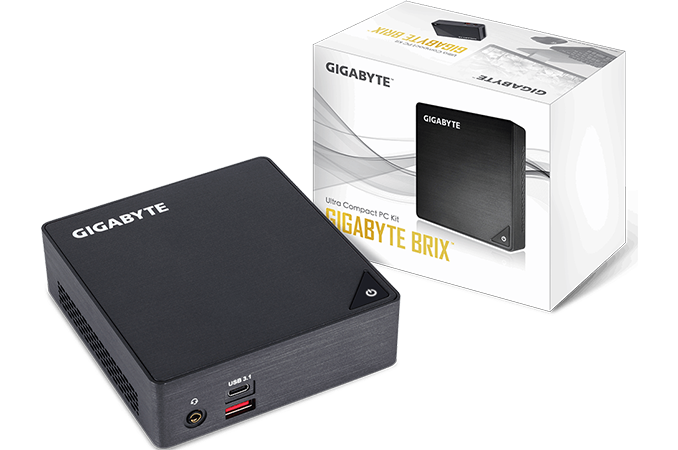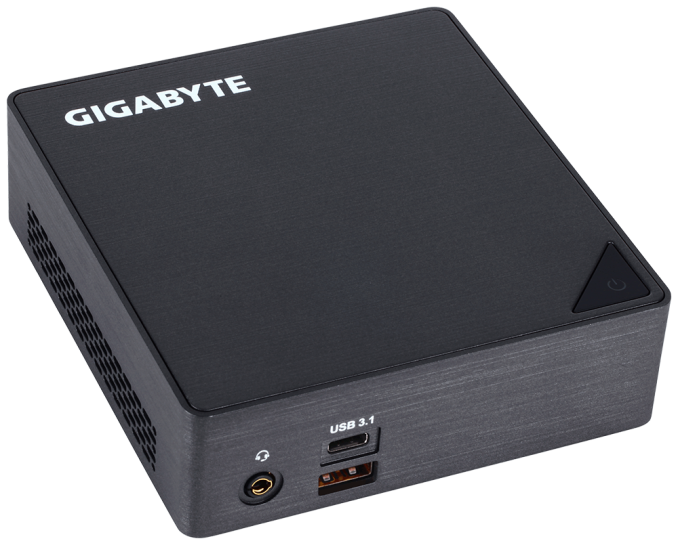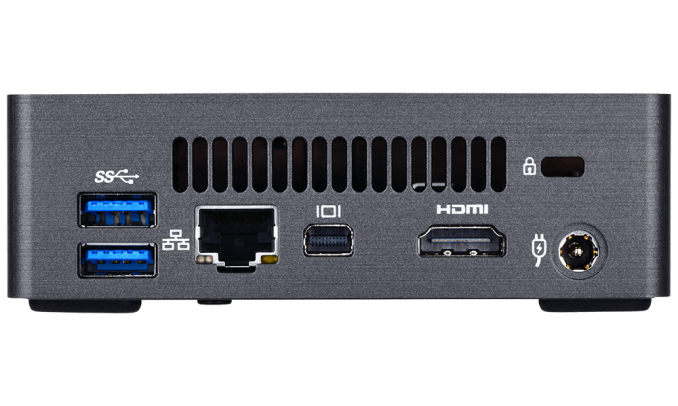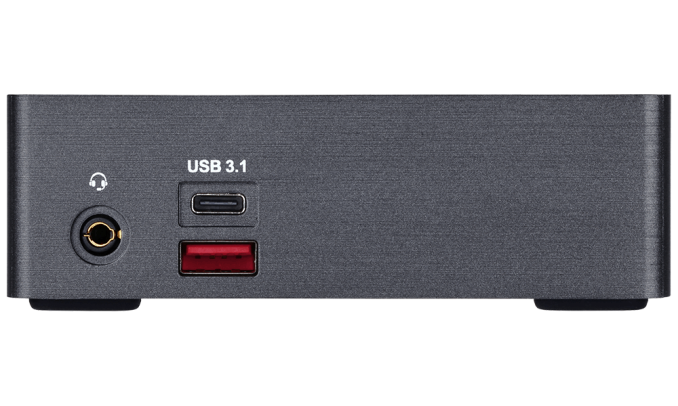GIGABYTE Updates BRIX SFF PCs with Intel’s Kaby Lake CPUs
by Anton Shilov on October 12, 2016 11:00 AM EST
GIGABYTE has updated its BRIX family of small form-factor PCs with Intel’s latest Core processors featuring the optimized Kaby Lake microarchitecture. The new systems are promoted to offer better performance than their predecessors, but are otherwise identical to BRIX PC powered by Intel’s Skylake processors: they support DDR4-2133 memory, M.2-2280 NVMe SSDs, 802.11ac Wi-Fi, USB Type-C connectors and use Intel NICs. Apart from performance, the notable improvement the new BRIX systems have are HDMI 2.0 outputs which we suspect to be via provided via an onboard LSPCON.
As Intel’s 7th generation Kaby Lake-U CPUs are drop-in compatible with motherboards supporting the Skylake-U chips, GIGABYTE uses exactly the same chassis for the new BRIX PCs featuring previous-gen processors: one is 0.46 L in volume and another is a bit larger at 0.6 L. Meanwhile, the new PCs also have better CPU and GPU performance due to higher frequency and improved architecture. Besides, the latest BRIX PCs come with HDMI 2.0 outputs, thus supporting 4K (4096×2160 pixels at 60 Hz) resolution (the HDCP 2.2 tech compulsory for certain content is supported). By contrast, the predecessors of the new BRIX systems only had HDMI 1.4b connectors (they still had mDP 1.2 ports with 4Kp60 support).
| GIGABYTE BRIX SFF PCs Based on Intel's Kaby Lake CPUs | ||||||||
| 0.6 L with 2.5-in 'HA' |
0.46 L without 2.5-in 'A' |
|||||||
| GB-BKi7HA-7500 | GB-BKi5HA-7200 | GB-BKi3HA-7100 | GB-BKi7A-7500 | GB-BKi5A-7200 | GB-BKi3A-7100 | |||
| CPU | i7-7500U 2C/4T 2.7 GHz 3.7 GHz |
i5-7200U 2C/4T 2.5 GHz 3.1 GHz |
i3-7100U 2C/4T 2.4 GHz |
i7-7500U 2C/4T 2.7 GHz 3.7 GHz |
i5-7200U 2C/4T 2.5 GHz 3.1 GHz |
i3-7100U 2C/4T 2.4 GHz |
||
| GPU | HD Graphics 620 24 EUs up to 1050 MHz |
|||||||
| RAM | 2×DDR4-2133 SO-DIMMs (up to 32 GBs) | |||||||
| SSD | Up to M.2-2280 SSDs | |||||||
| HDD | 2.5"/9.5 mm | - | ||||||
| GbE | Intel i219LM | |||||||
| Wi-Fi | Intel 3168 1×1 802.11ac + BT 4.2 (via M.2 2230 card) |
|||||||
| I/O | USB 3.1 (10 Gbps) via ASMedia ASM1142 1×USB 3.1 Type-C 1×USB 3.1 Type-A 2×USB 3.0 Type-A |
|||||||
| Video | 1×HDMI 2.0 (HDCP2.2) via LSPCon 1×DisplayPort 1.2 |
|||||||
| Audio | Realtek ALC255 (ALC3234, an ALC268 variant) TRRS and HDMI connectors |
|||||||
| Size | H: 46.8 mm W: 112.6 mm L: 119.4 mm |
H: 34.4 mm W: 112.6 mm L: 119.4mm |
||||||
| Full Specs |
GB-BKi7HA-7500 | GB-BKi5A-7200 | GB-BKi3A-7100 | GB-BKi7A-7500 | GB-BKi5HA-7200 | GB-BKi3HA-7100 | ||
The audio codec is perhaps a downside, with a laptop-class ALC255 in use, however we see an Intel NIC on board which is typically a requirement for embedded management systems. I would suspect that GIGABYTE will offer these units with vPro enabled hardware/software to specific business customers if needed.
Since GIGABYTE BRIX SFF systems are barebones, end-users or systems integrators will have to equip them with their own DDR4-2133 SO-DIMM memory, an M.2 SSD and/or a 2.5” hard drive (0.6 L BRIX PCs only). Since the computers are based on Intel’s Core i-series mobile processors in BGA packaging, they cannot be upgraded with better CPUs and GPUs. As there's no Thunderbolt 3, there's no provision for external GPUs with Kaby Lake at this time.
GIGABYTE did not announce recommended prices or release dates of the new BRIX systems, but MSRPs should be similar compared to existing SFF PCs based on Intel’s Skylake processors. As for availability, typically we see devices like this on sale in 2-4 weeks after the manufacturer lists them on their website.
Source: GIGABYTE


















28 Comments
View All Comments
JoeyJoJo123 - Wednesday, October 12, 2016 - link
The branding is fine, people need to consider desktop class CPUs range from Celerons to i7s, according to the advertised price per unit.Likewise mobile class has their own CPUs which range from Celerons to i7s, according to the advertised price per unit.
It's no different than how Nvidia (used) to sell mobile graphics chips such as GTX 970Ms having completely different performance to desktop class GTX 970s. (Today the M branding is gone on GTX 1000 series mobile GPUs, and the gap between desktop class and mobile class has diminished greatly, but they are different SKUs... Just named differently.)
If you want annoying labeling, look no further than the GTX 1060 3GB vs GTX 1060 6GB. It's implied that the GPU is the same, and it is the same GP106, but in addition to a different amount of VRAM, the GTX 1060 3GB disables 10 stream processors, leading to an actually significant performance gap.
People need to just stop comparing desktop to mobile class products. They're different classes of products.
niva - Wednesday, October 12, 2016 - link
Is the a single CPU core of the desktop i7 equivalent to a laptop i7 and as access to the equivalent cache/etc?If not, then the label is misleading and bad.
Just because they do it, and have done it for a while, doesn't make it right.
JoeyJoJo123 - Wednesday, October 12, 2016 - link
Different product stacks, quit comparing them. If you want to identify quad-cores on a mobile CPU, look for the Q suffix. If it doesn't have it, it's likely not a quad-core.i7, i5, i3 refer to pricing segments, not absolute performance, so quit looking at them as an indicator of true performance and look at them rather as how much Intel charges for it.
i7 mobile is different from desktop i7. Desktop Nehalem i7 is a different generation from Desktop Skylake i7. I hear way too often from casual PC users that they got an "i7 under the hood and an blazing fast SSD" on their home PC, yet they still have a relatively slow Nehalem i7 and a SSD limited to SATA II 3.0 Gbps speeds, which is quite a bit slower than what a modern Skylake i5 6600k + PCIe-based NVMe M.2 SSD can offer.
The problem in general is that people keep using branding like i7, i5, i3, "SSD" as terms of "performance" when they're not being absolutely specific about what the technology represents. Intel solves this with the SKU labeling, but people are oblivious to that, and keep thinking that i7 means it's the absolute best-of-the-best processing power in the entire world. It's not. And it never meant that, nor did it ever imply that.
Intel's used prefixes and suffixes in the SKU labels since Nehalem, when they began to use i3, i5, i7 branding to refer to specifics of the processor package.
smilingcrow - Wednesday, October 12, 2016 - link
It's not misleading at all except for people who are ignorant and that is their issue.Note to the ignorant: i7 just means best in that 'class' of chip so currently that means dual core only for 15W and under. Simple really. Take a deep breath and relax.
Strunf - Thursday, October 13, 2016 - link
The branding is NOT fine... branding is a way to appeal to people expectations and even mislead them. If i3 , i5 and i7 mean nothing as you state then there's no reason for it to exist... it exist cause the i3, i5 and i7 represent something on people head and Intel wants to capitalize on that. Their goal is to make people think that an i7 mobile would be somewhat as good as a desktop i7, that's their only goal, mislead people... and it works plenty of people around me buy laptops with i7 thinking that would be MUCH better than an i5 or i3, when well the difference is minimal. Sure let's instruct everyone to forget the i3, i5 and i7 stuff and look to the SKU but that isn't what Intel wants otherwise no one would be buying (or less would) mobile i7 or even desktop i7.nVidia does the same... marketing exists for a reason... and making you pay more for features you don't need or not really worth it is the number one goal of any marketing campaign.
JoeyJoJo123 - Thursday, October 13, 2016 - link
>Their goal is to make people think that an i7 mobile would be somewhat as good as a desktop i7No. It's not. Their goal is that they have a bunch of chips that range in performance and power usage, so their goal is to divide them into 5 product tiers in every generational leap.
Desktop's worst chip offerings are branded as Celerons, and the best are labeled as i7's.
Notebook's worst chip offerings are branded as Celerons, and the best are labeled as i7's.
The i7's in the desktop class have always been different from the i7's in the Notebook class.
It's no different than having identical trim levels across different cars in your entire lineup of vehicles if you're a car salesman.
For Honda, they typically range from LX as the base trim, to Sport, Sport Premium, EX as their highest trim.
You can get a Honda Fit EX (think Honda Fit i7), which means it's the highest tier offering for the Honda Fit, but it's not really comparable to performance and features you might find on the Honda Accord EX. They're two different classes of cars. Same way desktop and mobile are two different classes of products meant for two different classes of computing solutions (mobile, light, power-optimized for battery longevity vs raw performance in a large desktop case, with high IPC for common single-threaded desktop applications).
fanofanand - Thursday, October 13, 2016 - link
Actually it would be more like the accord and fit both being called Honda xyz 123 vs Honda xyz 456. Except in this case higher numbers don't indicate higher performance except for within their own "tier". It is bad branding and the butthurt from the super informed here is ridiculous. An average consumer wouldn't know the difference and that's why Intel does it.JoeyJoJo123 - Wednesday, October 12, 2016 - link
https://www.youtube.com/watch?v=G2y8Sx4B2SkYou keep using that word. I do not think it means what you think it means.
i7, i5, i3 labels has no connection or reference to the amount of cores.
i7, i5, i3, pentium, and celeron are advertising labels used to refer to different tiers within the same product stack of a particular generation of hardware, and are simply incomparable to i7's, i5's, i3's, pentiums, and celerons in a different product stack. Likewise, it's important to note to never compare i7s, i5s, i3s between different hardware generations.
What you're doing is comparing standard desktop-class (possibly even unlocked "K" SKUs) i7s and i5s to ultra-low voltage "U" i7 mobile-class processor SKUs.
Here's what actually refers to the actual number of processor cores, the actual letters in the SKU label. Here's a chart:
Prefix G - Pentium/Celeron, rather than i#-series processor.
Suffix K - Unlocked Multiplier, when used with the proper overclocking motherboard chipset, on Desktop-class SKUs.
Suffix S - Low Power, in terms of TDP Wattage, on Desktop-class SKUs.
Suffix T - Very Low Power, in terms of TDP Wattage, on Desktop-class SKUs.
Suffix X - Extreme edition, on Desktop-class SKUs.
Suffix R - Iris Pro Graphics + BGA packaging, on Desktop-class SKUs. (Read: BGA processors are soldered to board)
Suffix P - Lower class Graphics (HD510 as opposed to standard HD530, for example), on Desktop-class SKUs.
Suffix U - Very Low Power, in terms of TDP Wattage, on Mobile-class SKUs.
Suffix Y - Ultra Low Power, in terms of TDP Wattage, on Mobile-class SKUs.
Suffix Q - Quad core, on Mobile-class SKUs.
And there's way more. So how about an example:
i7 6700HQ = Quadcore, because Q means quadcore.
i7 6600U = Does not have a Q, and the U implies low power, so it's definitely not a quad-core.
Both are still in the same segment of i7 pricing, as opposed to i5 pricing. So an i5 6300HQ does have 4 cores and it's cheaper than an i7 6600U, but the i7 6600U has the nearly the same core speeds of 2.3Ghz base and 3.4Ghz turbo for the i7 and 3.2Ghz turbo for the i5, but the i5 has a TDP of 45W compared to the i7's paltry 15W.
There are a _number_ of reasons why certain processors are i7s and others are i5s, but don't go around comparing i5s and i7s from different generations and or desktop vs mobile vs embedded comparisons, it just makes you look stupid.
smilingcrow - Wednesday, October 12, 2016 - link
You just don't understand branding/marketing so your hatred is really self hatred due to your ignorance and ego projected outward which is a common form of delusion.The best medicine is to meditate.
JoeyJoJo123 - Thursday, October 13, 2016 - link
>I don't understand branding>I'm explaining Intel's branding which apparently doesn't make sense to you.
>Somehow I'm the one full of hatred and I don't understand hatred.
Sounds like the pot calling the kettle black. I'd advise you to reread the comment and educate yourself before engaging in a discussion which you know nothing about.